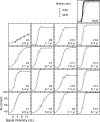Psychometric functions for pure tone intensity discrimination: slope differences in school-aged children and adults
- PMID: 19206879
- PMCID: PMC2654578
- DOI: 10.1121/1.3050273
Psychometric functions for pure tone intensity discrimination: slope differences in school-aged children and adults
Abstract
Previous work on pure tone intensity discrimination in school-aged children concluded that children might have higher levels of internal noise than adults for this task [J. Acoust. Soc. Am. 120, 2777-2788 (2006)]. If true, this would imply that psychometric function slopes are shallower for children than adults, a prediction that was tested in the present experiment. Normal hearing children (5-9 yr) and adults were tested in a two-stage protocol. The first stage used a tracking procedure to estimate 71% correct for intensity discrimination with a gated 500 Hz pure tone and a 65 dB sound pressure level standard level. The mean and standard deviation of these tracks were used to identify a set of five signal levels for each observer. In the second stage of the experiment percent correct was estimated at these five levels. Psychometric functions fitted to these data were significantly shallower for children than adults, as predicted by the internal noise hypothesis. Data from both stages of testing are consistent with a model wherein performance is based on a stable psychometric function, with sensitivity limited by psychometric function slope. Across observers the relationship between slope and threshold conformed closely to predictions of a simple signal detection model.
Figures





References
-
- Allen, P., and Wightman, F. (1994). “Psychometric functions for children’s detection of tones in noise,” J. Speech Hear. Res. JSPHAH 37, 205–215. - PubMed
-
- Allen, P., and Wightman, F. (1995). “Effects of signal and masker uncertainty on children’s detection,” J. Speech Hear. Res. JSPHAH 38, 503–511. - PubMed
Publication types
MeSH terms
Grants and funding
LinkOut - more resources
Full Text Sources
Miscellaneous

